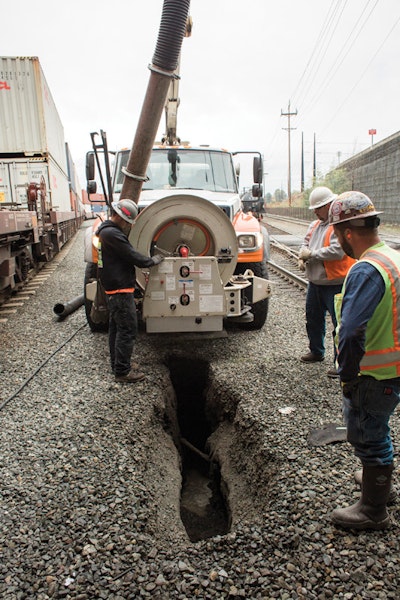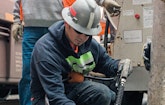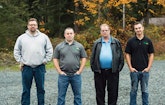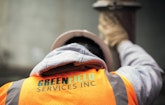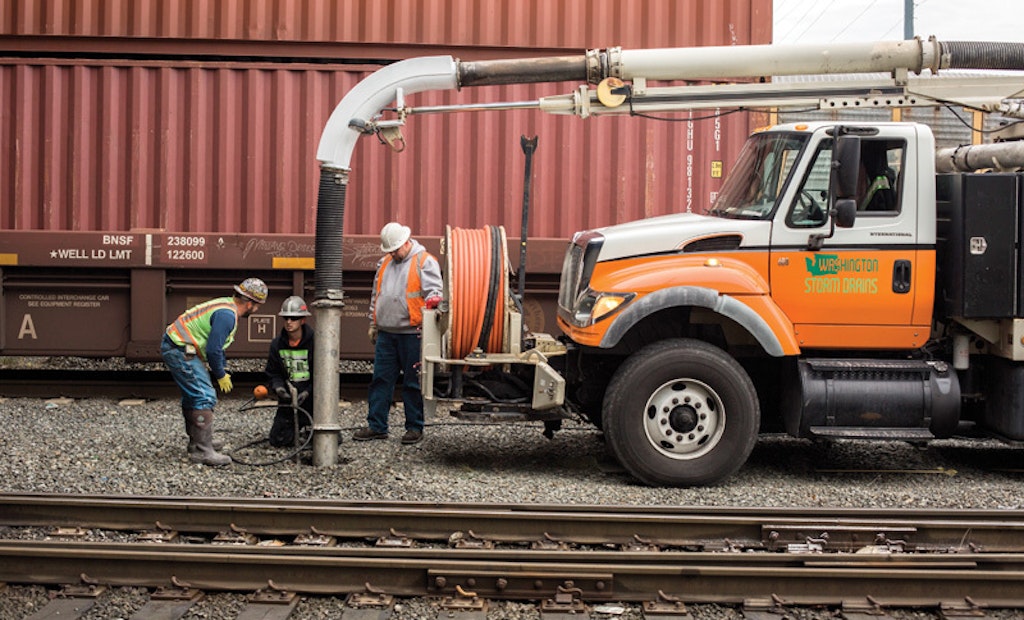
Interested in Municipal/Industrial?
Get Municipal/Industrial articles, news and videos right in your inbox! Sign up now.
Municipal/Industrial + Get AlertsJacob Sabin built a strong foundation for his excavating business a few years ago by primarily focusing on traditional machinery and techniques. But now that Greenfield Services in Puyallup, Washington, is firmly established, he’s intent on employing different technology — hydroexcavating — to take his company to the next level.
When Sabin struck out on his own in 2013, he concentrated on basic services such as residential and environmental excavation. Just four short years later, the company does everything imaginable: land clearing, excavation work for laying water and sewer lines and installing grease traps, digging construction footings, exposing buried utility lines, remediation of contaminated soil, sewer line jetting and vacuuming, and cleaning car-wash sumps, to name a few.
Why branch out into so many different services? Sabin realized that the more he offered, the more attractive his company looked to potential customers who’d rather hire a one-stop shop than deal with multiple contractors. Moreover, as the saying goes, one thing inevitably leads to another. One job can unexpectedly generate more work as problems arise.
“They absolutely do complement each other,” he points out. “Hydroexcavating creates work for excavating and vice versa, for example. We go out and jet a line, for instance, and find a break in the line that needs repair or replacement. So then we can send out an excavation crew. That’s a good example of how these two divisions complement each other so well.”
Diversified services also help to offset cyclical highs and lows, especially in boom-or-bust markets like construction. “I like to be diversified so it evens things out — there’s not so much up and down in terms of business cycles,” he points out.
The backbone of the company’s hydroexcavating division is a Vac-Con combination vacuum truck with a hydroexcavation package, built on a 2004 International truck chassis. While hydroexcavating currently generates only about 20 percent of the company’s gross revenue, it produces higher profit margins than any of the company’s other services. As such, Sabin is interested in expanding further into the hydroexcavating market.
“I have every intention of growing the hydroexcavating division,” Sabin says. “I’d love to buy another hydroexcavating truck every year.”
Quality and growth
The diversified approach generated rapid growth. In just four short years, the company’s annual revenues have grown almost eight-fold, from $350,000 in 2013 to about $3 million in 2016.
Aside from diversified services, Sabin’s formula for this remarkable growth spurt wasn’t all that complicated: Hire great employees. Create an I’ve-got-your-back company culture that promotes teamwork. And invest in quality equipment that boosts productivity and, in turn, increases customer satisfaction.
“We probably have hundreds of guys doing excavating in western Washington,” says Sabin. “The only way to compete is to out-perform everyone else. And we do that by investing in quality equipment and keeping it well maintained, as well as hiring quality employees.”
In addition, Sabin points out that he never low-balled on job bids in order to gain a foothold in his service area. “I’ve never worked cheap,” he notes. “I’m not a cheap guy, I’m a quality guy. I believe that quality sells itself. If you do a good job for everyone you work for, they’ll tell other people about it.”
Sabin relies heavily on one of his excavating foremen, Nick Watkins, whom he recently promoted to a superintendent in order to free up more time for Sabin to find more hydroexcavating customers.
“Nick is a great employee,” Sabin continues. “He went from working as a pipe layer to equipment operator, to foreman and now to superintendent. I’ve got really good employees — I’m very blessed. They’re really loyal, honest and hardworking people.”
Sabin also praises John Raring, manager of the company’s hydroexcavating division. He not only operates the hydrovac truck, he also helps out with sales and customer service. “Since he runs the truck, he’s out on the front lines — the guy who makes it all happen,” Sabin says. “He’s really kicking butt and is willing to work long hours without compromising quality.
“John also frees up my time to focus on managing, which is critical,” Sabin adds, noting he used to operate the hydroexcavating truck. “I strongly believe that profit margins are won or lost based on how well you manage operations.”
His own way
The seeds of Sabin’s career were sown in high school. He worked on farms and discovered he loved to drive tractors. Because he struggled academically, he knew college wasn’t in the cards. So upon graduation, he instead took a job as a heavy-equipment operator, building logging roads. “It was an awesome experience,” he says.
Eventually, Sabin worked for other companies and learned how to operate excavators and bulldozers, and drive dump trucks. He also learned how to do excavating for laying new water and sewer lines.
Along the way, he also learned something else: He’d rather work for himself than for somebody else. “The truth of the matter is that I’m not a great employee,” he candidly notes. “I’m headstrong and opinionated and that usually doesn’t go over well.
“Too often, someone would ask me to do something the wrong way — cut corners and do things on the cheap,” he continues. “I struggled with that, because I take a lot of pride in what I do. The bottom line is if you don’t want a quality job, you’ve hired the wrong guy.”
So Sabin decided to strike out on his own. It wasn’t a completely daunting task, since he’d already developed relationships with potential customers. Between that and word-of-mouth referrals, he soon financed the purchase of a Caterpillar 304 mini-excavator. “It was a very versatile piece of equipment, but still was small enough that I could tow it with a pickup truck,” he explains.
From there, he gradually added more equipment, primarily through rent-to-purchase arrangements. “That way, if I finished up a job but had no more work lined up for that particular machine, I could turn it back in — no harm, no foul,” he says. “It takes a lot of risk out of the initial purchase.”
Hydro power
The center of Greenfield’s push into hydroexcavating is a Vac-Con combination vacuum truck with a hydroexcavating package that is largely immune to breakdowns. Built on a 2004 International truck chassis, the unit features a 12-cubic-yard debris tank, a three-stage Vac-Con blower, a 1,300-gallon water tank and a water pump that generates pressure of 3,000 psi and flow of up to 80 gpm.
The hydrovac truck is used for a wide array of services, ranging from excavating and removing contaminated soil, to exposing underground utility lines, to cleaning municipal water and sewer lines. And it keeps customers happy by running. And running. And running.
“I have prior experience with Vac-Cons and I think they’re the best product out there,” Sabin contends. “For a machine with so many moving parts moving at high speeds, it’s amazing how durable it is. Everything on it is made to last.”
Maximizing equipment uptime has been a critical factor in Greenfield’s success. “The truth of the matter is if you have a new customer and you have to call them and say, ‘Sorry, our truck broke down,’ they won’t give you a second chance — you won’t get invited to the party again. Instead, they’ll just go down the list and the next guy up is going to get the chance to form that new customer relationship.”
Sabin says the Vac-Con moves more air volume than any other unit he’s worked with. That, coupled with the high-pressure water pump, makes short work of tough jobs. “Almost every week, we get a job where we’re digging, say, 20 feet deep and you’re 200 feet away from the truck,” he explains. “In fact, I’ve pulled 300 feet of distance with 15 feet of head pressure (elevation difference) and the truck still performed like a champ. And that’s without having to upgrade any features — it’s a really high-performance machine right out of the gate.”
Keep hustling
Bolstered by a healthy regional economy, Sabin expects the company’s growth to continue — at least in the long run. But in the short term, he plans to tone down expansion efforts in 2017 and instead focus on improving profit margins.
“Growth is expensive,” he notes. “Because of our rapid growth and the growing pains that come with it, I’m planning on slowing down a little in 2017 and focusing more on profitability.”
In the long run, Sabin says he’s motivated to keep building the business so it’s a strong and healthy entity when one or more of his four kids are old enough to take over, provided they’re interested. “I like the idea of building something my kids can take over — passing along a legacy to them, if they choose to become part of this industry,” he explains.
“The other part is that I’m greedy and lazy,” he says with a laugh. “It’s going to be awesome when I grow up some day and become comfortable financially. But in the meantime, I’m going to keep hustling and busting my butt every day — until I don’t have to anymore.”
